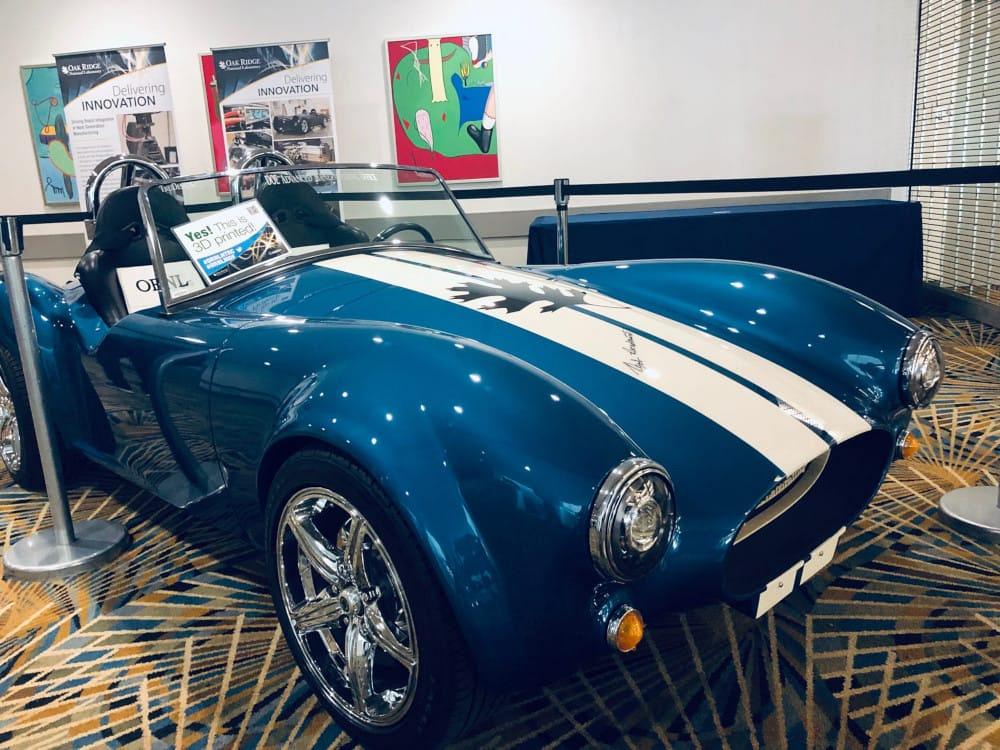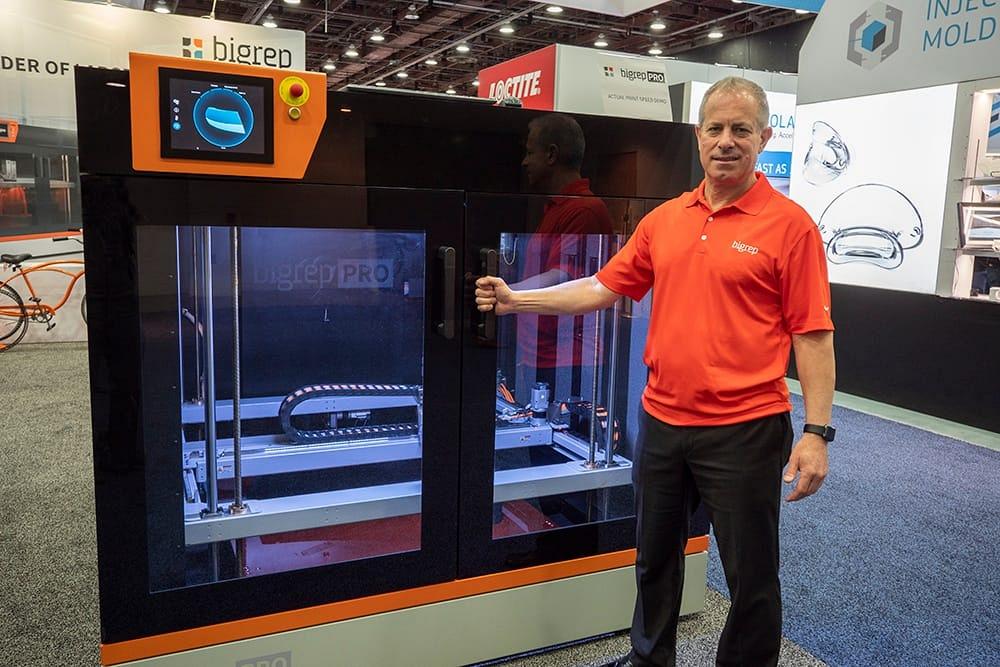Editor-in-Chief
- FMA
- The Fabricator
- FABTECH
- Canadian Metalworking
Our Publications
Categories
- Additive Manufacturing
- Aluminum Welding
- Arc Welding
- Assembly and Joining
- Automation and Robotics
- Bending and Forming
- Consumables
- Cutting and Weld Prep
- Electric Vehicles
- En Español
- Finishing
- Hydroforming
- Laser Cutting
- Laser Welding
- Machining
- Manufacturing Software
- Materials Handling
- Metals/Materials
- Oxyfuel Cutting
- Plasma Cutting
- Power Tools
- Punching and Other Holemaking
- Roll Forming
- Safety
- Sawing
- Shearing
- Shop Management
- Testing and Measuring
- Tube and Pipe Fabrication
- Tube and Pipe Production
- Waterjet Cutting
Industry Directory
Webcasts
Podcasts
FAB 40
Advertise
Subscribe
Account Login
Search
The excitement of “what we don’t know”—and other observations from RAPID + TCT
The Additive Report attended the RAPID show in Detroit last month to report on the latest 3D printing technologies and speak with industry leaders
- By Don Nelson
- June 15, 2019
I got smarter at last month’s RAPID + TCT show in Detroit. I saw a lot of new 3D printing technologies and talked with a bunch of attendees and exhibitors who shared their insights about the current state of additive manufacturing and the direction it is heading.
Moreover, they were upbeat and fun to talk with—and are primed to ensure that AM plays a key role in tomorrow’s manufacturing.
I also worked with The Additive Report video team for the first time. Our daily reports from the show floor highlight some of the many technologies exhibited and present interesting commentary from industry leaders.
RAPID marked a homecoming of sorts for me as well. I was born in Detroit and lived in the area half my life. I haven’t spent any extended time in “The D” in decades, so it was nice to witness the revitalization of downtown first-hand.
Below are some of my favorite takeaways from RAPID 2019. (All images and clips are gathered in a slideshow at the bottom of the page.)
Interview with additive manufacturing consultant and publisher Terry Wohlers. The publisher of the Wohlers Report—the authoritative annual guide to the global AM market—has been involved with 3D printing since the technology’s inception more than 30 years ago.
Wohlers’ enthusiasm for all things AM is contagious, and his knowledge of the subject is seemingly bottomless.
My favorite comment during our interview was his makes-you-think response to a question about the appeal of AM for young people: “What we know is exciting, and what we don’t know is even more exciting.”
Indeed.
Favorite déjà vu moment. On display outside the main hall I caught site of a Shelby Cobra that looked familiar. It was. The Additive Report website features a pictorial about Oak Ridge National Laboratory, which 3D-printed the operable car on a CINCINNATI BAAM (Big Area Additive Manufacturing) machine. Note: The car’s detailing in real-life is stunning.

Terry Wohlers (left), additive manufacturing consultant and publisher of the Wohlers Report, discusses young people working in the 3D printing industry with Additive Report Editor Don Nelson.
3D printer exec says small companies will play big role in AM’s acceptance. Most people in manufacturing maintain that 3D printing’s growth and acceptance will depend on large companies like GE, Ford, and John Deere committing to the technology. The president of BigRep America, Frank Marangell, is not among them.
He contends that small-to-midsize manufacturers will be the prime drivers of AM’s growth. One reason is that smaller companies can prototype, test, build, and bring a new part online, for example, much faster than their larger counterparts. Another reason is that big manufactures are more risk-averse.
As an example, Marangell cited BigRep customer Boyce Technologies, a manufacturer of parts and housings used by the mass-communications industry.
The company’s owner, Charles Boyce, found that by simply changing the material used to 3D-print a prototype, he could print the needed parts and eliminate having to machine hard tooling.
“John Deere and General Motors couldn’t do that,” said Marangell. “The risk to their brand would require them to evaluate something like that for years and years. Charles came into the plant one Saturday, tested it, found that it worked, and said, ‘Let’s go forward.’ These guys that are small-to-midsize manufacturers make their own decisions. Their brand is their name.”
The color of startups. Origin got on the AM map by developing a platform called Open Additive Manufacturing that brings together open materials, extensible software, and modular hardware.
At RAPID, the four-year-old company raised its profile further with the introduction of Origin One, a modular 3D printer for polymers.
The sleek, black machine looked right at home in the black Origin booth staffed with workers dressed in all black. When company CEO and co-founder Chris Prucha handed me his business card—a striking jet-black card with reversed-out white letters—I noted that “there’s a lot of black around here.”
He smiled and said with a shrug, “We’re a startup.”
Almost a free ride. The Detroit People Mover is a driverless train that stops at 13 stations along a 2.9-mile route around downtown. Riders get an up-close view of Detroit’s rich architecture and a thrilling view of the Ambassador Bridge, which connects the city with Windsor, Ontario.

Oak Ridge National Lab 3D-printed this Shelby Cobra, which was displayed in Detroit and appears in a pictorial posted on the The Additive Report website.
I rode the DPM twice a day, coming and going to my hotel in the Renaissance Center. Cost: Seventy-five cents. Best deal in The D.
Machine that 3D-prints small PCBs. I used to report on miniature printed circuit boards and other small electronic components, so I was amped to visit the Nano Dimension booth to see its DragonFly PCB prototyping system.
Intended for the “precision additive manufacturing of printed electronics,” DragonFly simultaneously 3D-prints dielectric polymers and conductive metals to micron precision, said the company’s vice president of global sales and customer care, Tim Sheehan.The accompanying image shows a 12-layer PCB printed on the DragonFly.
It measures 80 by 65 millimeters; the traces and spaces are 100 microns and 125 microns thick, respectively; and the build took 20 hours.
Panel speakers shares advice learned on the job. Women in 3D Printing, a global network of women involved in the additive manufacturing industry, hosted a panel discussion about AM. The speakers represented a cross section of 3D printing users: automotive engineer, Air Force composites expert, biomedical engineer, and contract manufacturing executive.
The panelists shared solid, practical advice based on their own work experiences. Among the topics discussed were transitioning from prototyping to production; how to 3D-print parts quickly and cheaply while maintaining control of the process; meeting quality requirements; and steps that can, and should, be taken to standardize and regulate the AM industry.
Favorite quote about 3D-printing parts: “Part 1 should be the same as Part 100 and the same as Part 1,000,” said Rapid Prototype & Manufacturing President Tracy Albers. “But when you’re working with machines meant to produce one part at a time, that doesn’t always happen.“We [industry] need to do a better job qualifying when 3D printing is an appropriate technology for the job at hand,” she said.
My favorite meal in Detroit. Sometimes a hot dog is more than just a hot dog. Sometimes it’s a Coney dog.
The Coney, a Detroit original, consists of an-all beef, natural-casing frank that’s gently nestled in a steamed bun and then topped with beanless chili, chopped onions, and a bold yellow stripe of mustard.
The best Coney in The D is at The Old Shillelagh—an iconic downtown restaurant/bar where every day is St. Patrick’s Day and the street leading to it rises up to meet you.

BigRep America President Frank Marangell believes small-to-midsize manufacturing companies will drive the use of industrial 3D printers.
Auburn University—more than football. Though best known nationally for its football team, Auburn is also renowned for its Samuel Ginn College of Engineering. Ginn alumni include four astronauts and Apple CEO Tim Cook.
A representative of Ginn College’s office of the dean, Michael Ares, visited The Additive Report’s booth the day before the exhibition opened to update me on NCAME, the school’s National Center for Additive Manufacturing Excellence.
The two-year-old research facility is an outgrowth of a partnership between the university and NASA. Initially, said Ares, NCAME is focusing its research efforts on the aerospace and oil and gas sectors.
The most recent news about the center was that NASA had awarded it a $5.2 million contract to develop additive processes and techniques for improving the performance of rocket engines.
The happiest person at the show (tie). The smiles of Protolabs Applications Engineer Eric Utley and Global Segment Manager for Medical Sales Annie Cashman lit up the room during our interview about the company’s 3D printing program.
The Maple Plain, Minn., company acquired a small prototyping shop in North Carolina in 2014, built a new AM facility in the state in 2016, and currently operates more than 100 3D printers, employs 180, and ships 60,000 3D-printed parts monthly. The former shop is now one of the largest 3D printing plants in the world.
In addition to 3D printing, Protolabs manufactures parts via injection molding, machining, and fabricating. The company celebrated its 20th anniversary in May. Its founder’s mission was to reduce the time needed to produce and ship a part from months to days.
Utley said the company has achieved that during its history by “completely committing to digital manufacturing.
Oh, Canada! Cobo Center offers a great view of Windsor, which lies directly across the Detroit River. Windsor is Canada’s southernmost city and lies south of Detroit.
Boom! Bombed by a team member. While wrapping up videotaping on the final day of the show, Additive Report team member Steve Sokniewicz dropped a video-bomb.
Well played, Steve.
Sign of the times. Sintratec rolled out its latest 3D printer for the U.S. market at RAPID: the modular SLS Sintratec S2—and hoisted a sign with the perfect slogan for a 3D printing company: PRINT YOUR MIND.
About the Author

Don Nelson
2135 Point Blvd.
Elgin, IL 60123
(815)-227-8248
About the Publication
- Podcasting
- Podcast:
- The Fabricator Podcast
- Published:
- 04/16/2024
- Running Time:
- 63:29
In this episode of The Fabricator Podcast, Caleb Chamberlain, co-founder and CEO of OSH Cut, discusses his company’s...
- Trending Articles
- Industry Events
16th Annual Safety Conference
- April 30 - May 1, 2024
- Elgin,
Pipe and Tube Conference
- May 21 - 22, 2024
- Omaha, NE
World-Class Roll Forming Workshop
- June 5 - 6, 2024
- Louisville, KY
Advanced Laser Application Workshop
- June 25 - 27, 2024
- Novi, MI





























